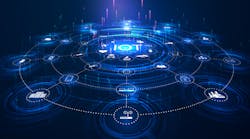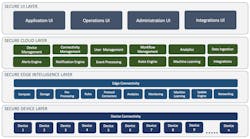IoT: The Electric Grid’s Final Frontier
As the grid evolves, the biggest changes are happening at the edge. People are installing roof solar panels, buying electric vehicles (EVs), installing home and building automation. These new categories of smart devices require a robust software backbone to help monitor and control the devices. For a utility, all of this is leading to an increased amount of uncertainty in basic things such as generation (from solar panels), load (smart homes and buildings, EVs). These grid edge technologies belong to a broad genre under the moniker of the internet of things (IoT). They generate massive volumes of data often inaccessible by the people responsible for monitoring and operating the grid, thereby leaving them bereft of critical operational insights.
Short Tutorial on IoT
IoT is a global system of devices, sensors, actuators, and controllers, interconnected and operating over computer networks and accessible over the internet.
IoT is the central nervous system of the connected world ushering in unprecedented visibility and awareness into the operational behavior, health of all systems in this connected workflow. IoT enables rapid, ongoing data-driven intelligent decision-making that is transforming all industries and segments. IDC predicts an installed base of 212 billion connected things by 2020. GlobalData forecasts spending on IoT technologies will reach US$318 billion by 2023.
IoT presents a set of new challenges. The sheer volume of data flowing into the systems and the associated workflow orchestration can be daunting.
A successful IoT strategy starts with targeted proofs of concept that rapidly demonstrate value allowing for investment to scale quickly. An IoT platform that seamlessly scales from proof-of-concept to enterprise-grade workloads is a key success indicator.
A high performing IoT Platform includes:
- Device authentication and connectivity
- Intelligent edge processing
- Hyperscale cloud services
- Responsive user interface
- Predictive, preventative analytics and actionable insights
- Automated end-to-end monitoring, fault detection and remediation
- Integrations with existing enterprise applications
- Rapid Application Development
Two Use-Cases: Nano/Microgrids and Commercial Buildings
The authors have selected nanogrids and commercial buildings to demonstrate how edge intelligence coupled with hyperscale cloud-based systems can analyze and generate actionable insights using real-time data.
Nano and microgrids:
A microgrid is a localized group of electricity sources and loads normally operating connected to and synchronous with the traditional distribution grid (macrogrid) but can also disconnect and function autonomously as geographical or economic conditions dictate. A nanogrid is smaller; its scope involving powering most components in a house.
A typical nanogrid includes:
- Energy sources such as solar panels or diesel generators
- Batteries to store energy
- A charge controller to regulate voltage and current generated by the solar panel
- Charging outlets to power appliances such as lights, cellphones, and refrigerators
Keeping energy production humming and effective requires 24x7 monitoring of overall system health and, if remote, the landscape and distances makes physical access to the system by licensed technicians impractical.
A cloud-based, automated, real-time remote operations management system continuously monitors the system and proactively detects situations that could compromise system efficacy. It conducts automated root cause analysis and sends automated alerts with relevant operational logs to engineers who review the data, troubleshoot situations remotely, and determine if a system has deviated from normal behavior.
Figure 2 shows multiple pieces of real-time information plotted over various time horizons. Notice the blue line dipping precipitously portending an impending failure scenario. Engineers can remotely define precise instructions for local technicians arming them with specific details needed to solve the problem.
In return, the end user’s service experience is seemingly uninterrupted availability of their nanogrid.
Commercial buildings
USGBC states that buildings account for 40% of national carbon dioxide (CO2) emissions. Energy efficient buildings have 34% lower CO2 emissions, consume 25% less energy and 11% less water.
Commercial buildings come with a heterogenous ecosystem of devices that don’t communicate with each other. Each device category has an IoT-like solution leading to a Frankenstein-like ecosystem with isolated data islands. Building automation systems, considered central to smart building initiatives have severe limitations including limited data (HVAC and lighting controls) collection which often stays internal.
Cloud-native, IoT operations management solutions seamlessly connect to the building controls network to automatically collect, identify, and map the data using artificial intelligence (AI) models. This solution requires minimal effort to setup and configure; no changes to existing IT network, policies, or tools required. Data is securely collected, transported, unlocked, stored, and managed.
The rich data collected facilitates rapid insight generation by focusing on areas that need attention. Figure 3 shows tenant comfort metrics like space temperature, CO2 levels, and equipment run times to identify poorly managed equipment. A holistic view of the entire building helps users quickly identify and address problematic areas.
Key Takeaways
- Next-gen solutions will move us away from manual processes to the world of information technology (IT)/operational technology (OT) using automation, enabling decisive action through actionable intelligence.
- Next-gen cloud-based IoT systems provide full historical data retention and data independence.
- IoT is reshaping smart grids. Today’s utility receives limited to no behind-the-meter (BTM) information. Decisively embracing IoT-initiated digital transformation will enhance all segments of the energy value chain.
- IoT-driven transformation starts by running proofs of concept using an enterprise-grade IoT platform in targeted areas with clearly stated goals.
Conclusion: Journey into the Final Frontier
With maturing technologies, enterprise and consumer expectations regarding IoT are rapidly evolving and becoming mainstream. Energy service and other providers need to determine mechanisms to leverage insights generated from always-connected systems.
Consumers are increasingly becoming sophisticated and leveraging network connected, distributed energy resources (DERs) to not only address their energy needs independently but also become energy producers.
IoT and IoT-enabled platforms are making a difference in developing and underdeveloped economies by bringing remote monitoring and analytics capabilities to support electrification which in turn raises the economic productivity of those historically disenfranchised communities. All of this sets us up well in the fight against climate change where optimization of energy usage leads to reduction in CO2 levels. Technologies exist today to support these capabilities and add significant flexibility in data management and interfacing with other enterprise systems.





